- In this source, we are greeted with a death threat to the Massachusetts senator Charles Sumner. The threat, written by a Ku Klux Klan member, writes about how he is displeased with Sumner’s proposition of an equal rights bill, and that if passed, will kill Sumner. The letter was made as an attempt to scare off Sumner, but failed in doing so, as the bill passed later with his support, although it was hardly enforced and eventually deemed unconstitutional a few years later. The most interesting part of the source is that fact that the KKK member threatens a white man of a higher power. This source is important as it shows that racists in the late 1800s America have no fears when it comes to doing what they feel they must to keep slavery in place. This piece’s value comes from showing the lengths the KKK were willing to go. Like today, politicians still had to deal with threats over their policies over a century ago.
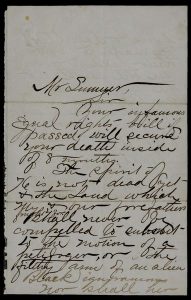
Unknown Ku Klux Klan member. Death threat from Ku Klux Klan to Charles Sumner. Letter. The Gilder Lehrman Institute of American History.Charles Sumner related items. http://www.americanhistory.amdigital.co.uk/Documents/Details/Death-threat-from-Ku-Klux-Klan-to-Charles-Sumner/GLC07202.03
- At the beginning of World War 2, President Roosevelt signed executive order8802 which prevented discrimination based on skin color and ethnic origin in the United States defense force. This came about when Roosevelt was pressured to end discrimination in the defense force by a black labor leader by the name of A. Philip Randolph. Randolph threatened to organize a march on washington comprised of thousands of blacks, which would have been a national embarrassment to the president. While the order did pass, it did not prevent discrimination in all fields of work. The executive order did set a precedent in the times to come when referring to discrimination in the workforce. This source is important as it shows the beginning of the abolishment of discrimination in the workforce towards minorities.
WHEREAS it is the policy of the United States to encourage full participation in the national defense program by all citizens of the United States, regardless of race, creed, color, or national origin, in the firm belief that the democratic way of life within the Nation can be defended successfully only with the help and support of all groups within its borders; and
WHEREAS there is evidence that available and needed workers have been barred from employment in industries engaged in defense production solely because of considerations of race, creed, color, or national origin, to the detriment of workers’ morale and of national unity:
NOW, THEREFORE, by virtue of the authority vested in me by the Constitution and the statutes, and as a prerequisite to the successful conduct of our national defense production effort, I do hereby reaffirm the policy of the United States that there shall be no discrimination in the employment of workers in defense industries or government because of race, creed, color, or national origin, and I do hereby declare that it is the duty of employers and of labor organizations, in furtherance of said policy and of this order, to provide for the full and equitable participation of all workers in defense industries, without discrimination because of race, creed, color, or national origin;
And it is hereby ordered as follows:
1. All departments and agencies of the Government of the United States concerned with vocational and training programs for defense production shall take special measures appropriate to assure that such programs are administered without discrimination because of race, creed, color, or national origin;
2. All contracting agencies of the Government of the United States shall include in all defense contracts hereafter negotiated by them a provision obligating the contractor not to discriminate against any worker because of race, creed, color, or national origin;
3. There is established in the Office of Production Management a Committee on Fair Employment Practice, which shall consist of a chairman and four other members to be appointed by the President. The Chairman and members of the Committee shall serve as such without compensation but shall be entitled to actual and necessary transportation, subsistence and other expenses incidental to performance of their duties. The Committee shall receive and investigate complaints of discrimination in violation of the provisions of this order and shall take appropriate steps to redress grievances which it finds to be valid. The Committee shall also recommend to the several departments and agencies of the Government of the United States and to the President all measures which may be deemed by it necessary or proper to effectuate the provisions of this order.
Franklin D. Roosevelt
The White House,
June 25, 1941.Exec. Order No. 8802, 3 C.F.R. (1941)
- In this video of Malcolm X’s speech, X talks to members of the black community on their appearance, inside and out, and who taught them to hate it. He asks why they attempt to distance themselves from their culture to make the white man tolerate them more, and tells them that they should not be ashamed of who they are. He calls for the black community to band together to fight against the common enemy that is the white man. This source is important as it shows the same common beliefs of MLK, but X goes about a completely different way in telling people to rise against the enemy and fight back. This source also reveals why a decent amount of whites felt uneasy against the blacks, as they felt aggression from them.
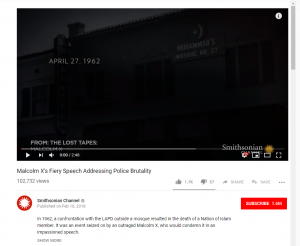
Malcolm X. “Malcolm X’s Fiery Speech Addressing Police Brutality” Smithsonian Channel, 2:48. 1962.
- The Black Panther Party originated as a group of black citizens who would keep watch over the police in their neighborhood in an attempt to prevent racial violence. When discovered that the police were not the ones creating the orders for violence against blacks, the party evolved into a more politically focused group. Their focus then was creating a more just government for blacks, attempting to have all blacks treated as equals in every way. The Panthers believed in nonviolent approaches to social issues, but were commonly seen as a violent group due to their carrying of weapons in self defence. This source is important as it documents the creed of the Black Panther Party, giving us a look inside their core beliefs and goals that they wished to accomplish.

The John Brown Society. An Introduction to the Black Panther Party. Berkeley, California. Radical Education Project, 1969
(Click picture for full text)
- One of the most widely known acts of protest against segregation in the south is Rosa Parks’ refusal to move to the back of the bus, where the blacks were required to sit. For this, she was arrested. She did not resist this arrest, she accepted it. Parks knew that nothing would be changed if the public view of blacks saw them as violent people. In this source, Parks gives a brief description of what happened on that day, along with what she thought during the moments of the acts. The most important thing to come out of this source is the quote coming from the police officer when asked why blacks had to be pushed around. He says he does not know, and that laws are laws. This shows that racism had become such a part of life that you did not even think about how blacks were treated differently, they just were.
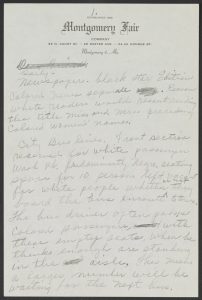
Parks, Rosa. Rosa Parks Papers: Writings, Notes, and Statements, 1956 to 1998; Drafts of early writings; Accounts of her arrest and the subsequent boycott, as well as general reflections on race relations in the South, 1956-, undated; Folder 2. – 1998, 1956. Manuscript/Mixed Material. https://www.loc.gov/item/mss859430226/
- In this source, Ella Baker speaks on a number of black and white students sitting in at segregated restaurant counters, protesting the act of segregation. She says that this is about much more than wanting only food. This is a movement based around the belief that blacks should no longer be treated as lower than whites, and deserve every right that the white man gets. Along with sit ins, the protesters were also using peaceful protest and not fighting back against any physical violence that they faced, this was the popular form of protest that would be used by Martin Luther King Jr. in the future. This source is important as it showcases, albeit briefly, the working together of blacks and whites in the racist south, attempting to gain more rights for the blacks. The source also shows the beginning of the non-violent protesting method, used prominently a few years later.
We want the world to know that we no longer accept the inferior position of second-
class citizenship. We are willing to go to jail, be ridiculed, spat upon and even suffer
physical violence to obtain First Class Citizenship.
By and large, this feeling that they have a destined date with freedom, was not limited to
a drive for personal freedom, or even freedom for the Negro in the South.
Repeatedly it was emphasized that the movement was concerned with the moral
implications of racial discrimination for the “whole world”; and the “Human Race”.Ella Baker, “Bigger than a Hamburger,” Southern Patriot, no. 18 (June 1960)
- The call for help by a southern black woman gives us insight into the mindset of people facing discrimination, and their desire to fight back. The letter, distributed around to many southern blacks just days after Rosa Parks refused to move to the back, calls for them to boycott the public bus system, showing the bus company that as the primary users of the busses they were not to be discriminated against. In the letter, the writer emphasizes how blacks are currently not allowed to sit towards the front of the busses, and must stand over any empty seats that are open in the white section. The author says that the bus riders can afford to miss a day of school or work, or can walk if really needed, showing the urgency in the author’s voice. This source is important as it shows racism and discrimination through the eyes of the people on the receiving end, and what they plan to do about it.
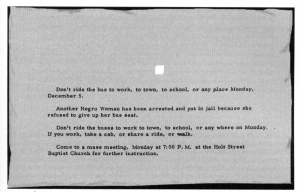
Women’s Political Council, untitled leaflet, 5 December 1955
- In the famous speech given by Martin Luther King Jr, King talks about how he has a dream that one day in America everyone will be treated equally, and not judged by what they look like, but instead by what they have to offer from their insides. This speech is important as it revitalized the civil rights movement, serving as a motivator and inspiration to blacks all over the country who had given up the hope of equal rights. One of the most important parts of the speech was the nonviolent approach, as a lot of focus in the past few years was on the more militaristic Malcolm X. This source is very important as it shows the beginning of the nonviolent movement led by Martin Luther King Jr, which eventually leads to the super important marches led by him.
I have a dream that one day this nation will rise up and live out the true meaning of its creed: “We hold these truths to be self-evident: that all men are created equal.”
I have a dream that one day on the red hills of Georgia the sons of former slaves and the sons of former slaveowners will be able to sit down together at a table of brotherhood.
I have a dream that one day even the state of Mississippi, a desert state, sweltering with the heat of injustice and oppression, will be transformed into an oasis of freedom and justice.
I have a dream that my four children will one day live in a nation where they will not be judged by the color of their skin but by the content of their character.
I have a dream today.
I have a dream that one day the state of Alabama, whose governor’s lips are presently dripping with the words of interposition and nullification, will be transformed into a situation where little black boys and black girls will be able to join hands with little white boys and white girls and walk together as sisters and brothers.
I have a dream today.
I have a dream that one day every valley shall be exalted, every hill and mountain shall be made low, the rough places will be made plain, and the crooked places will be made straight, and the glory of the Lord shall be revealed, and all flesh shall see it together.
King, Martin L. “I Have a Dream.” Speech presented at the March on Washington for Jobs and Freedom, Washington, D.C., August 1968. http://avalon.law.yale.edu/20th_century/mlk01.asp
- In this audio snippet, we meet an influential black woman named Fannie Lou Hamer. She is testifying during the DNC of ‘64, speaking of the injustices that she has witnessed, from police brutality to blackmail to attempt to get her to withdraw her voting application. Hamer was known for her work in setting up voter registration days for her fellow black Mississippians. This source is important as it paints a picture of the abuse that all blacks from the south had to endure. Ranging from emotional abuse with segregation, to physical abuse with the constant beatings from police if they were not careful. Perhaps the most horrifying part is the fact that Fannie gets beat by two of her fellow blacks, when in the jail cell.
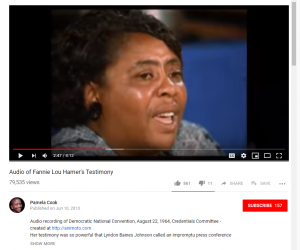
Fannie Lou Hamer. “Audio of Fannie Lou Hamer’s Testimony” Pamela Cook, 8:12. Aug 22nd, 1964
- In this photo, we see the march to Montgomery from Selma unfolding. The march was a demonstration led through rural Alabama to raise awareness for civil rights. This photo shows the large amount of blacks involved in the march to Montgomery, prepared to face any violence thrown at them just for the color of their skin. This source is important as it showcases the monumental event which led to the passing of the voters rights act, securing the blacks right to vote like every other American. With President Johnson introducing the voters right bill into congress shortly after the marches, it was also a confirmation to the marchers that the people of America were listening to their cries, and that their dream may not be too far away.
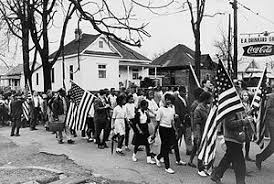
Unknown, Marchers on Edmund Pettus Bridge during the Selma to Montgomery March. March 7, 1965. Tourism Promotional Materials, Alabama. Bureau of Tourism and Travel, Selma.
